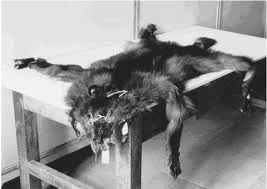In 1927, Lorenz hagenbeck bought one of three pelts from a dealer in Buenos Aires who claimed that they had come from a wild dog of the Andes. When Dr.Ingo Krumbiegel studied the skin in Germany in 1940, he concluded that it belonged to a new and still undescribed species.
In 1947, Krumbiegel connected the pelt with a skull he had discovered about ten years earlier. He claimed the skull was 31 centimeters long and belonged to an omnivorous canid substantially larger than a Maned Wolf, as Maned wolf skulls are smaller, about 24 cm. The skull had allegedly been lost in 1945 during World War 2 and was not available for peer review.
Krumbiegel began to reconstruct the animal from the skin. He noticed the legs were a lot shorter than the typical maned wolf, which is creature of open woodland and grassland habitats and uses its long legs to help it see, hear, and smell over the tall grass. He drew sketches of what he imagined this montane maned wolf looked like.
Krumbiegel thought the animal was unique enough that it deserved its own genus. He initially gave it the name Oreocyon hagenbecki or “Hagenbeck’s mountain dog,” but on learning that Oreocyon had been used before, he changed it to Dasycyon hagenbecki–“Hagenbeck’s thick (furred) dog.”
A 2000 attempt at DNA Analysis of the remaining pelt at Munich’s zoological museum failed because it was contaminated with human, dog, wolf, and pig DNA, and had been chemically treated.
No one has tried to extract DNA from the anomalous pelt since 2000. It’s generally been ignored. We do have better techniques for DNA extraction now, so maybe it is worth another go. The truth is we really don’t know, but if we were to find out that it was something that spectacular, the question ultimately would be whether this animal still exists.








0 comments:
Post a Comment